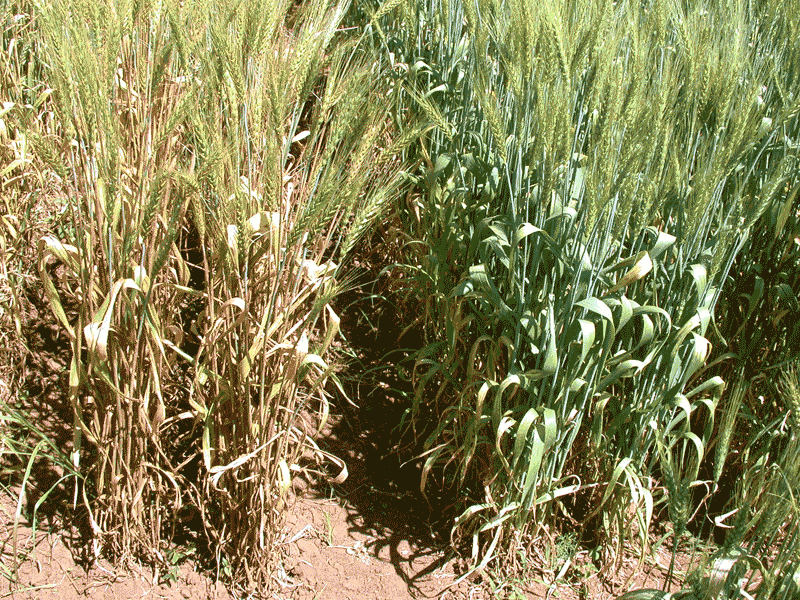Preparing for (another) disease siege
CANADIAN RESEARCH INTO UG99
CANADIAN RESEARCHERS CONTINUE to advance global efforts to fight back against the devastating stem rust disease known as Ug99 and their work may offer the key to fortifying farmer’s defenses in coming years.
PHOTO: A STARK CONTRAST SHOWING THE EFFECTIVENESS OF RESISTANCE GENES

Ug99 was originally found in Uganda in 1999 and, according to the experts of the Borlaug Global Rust Initiative, it has since affected Kenya, Ethiopia, Sudan, Eritrea, Yemen, Iran, Mozambique, Zimbabwe, Tanzania, and South Africa. During the same period of time, the disease has overcome resistance genes that have been protecting wheat for more than 50 years and now only five to 10 percent of 200,000 wheat varieties used in 22 African and Asian countries demonstrate adequate resistance.
Dr. Tom Fetch, a research scientist with Agriculture and Agri-Food Canada (AAFC) has been involved in assessing the resistance ability of Canadian wheat varieties since 2004. In his first trap nursery, planted in Kenya in 2005, Dr. Fetch evaluated 100 random, Canadian varieties to gauge how hard Ug99 might hit farmers in this country.
“The bad news is, it was virulent on all but two lines, but the good news is those couple of resistant lines that we saw were really very good,” recalls Dr. Fetch, “and we later found out that they actually have the same resistance in a gene called SrCad”.
PREPARING AGAINST IMMEDIATE ATTACK
Following the discovery of SrCad, and a companion gene known as Lr34, Dr. Fetch has been working to mount a Canadian defence against Ug99 in two ways. First, he created a network of scientists to monitor for early detection of the disease here. Second, he is helping wheat breeders ensure that the few resistance genes available here are maintained.
Eight years later, Dr. Fetch is happy to report that SrCad continues to hold up against Ug99 at the Kenyan test site. This is significant considering highly effective (Sr24 and Sr36) resistance genes have already been circumvented by the disease. However, the two cultivars with the SrCad+Lr34 gene combination are not popular among farmers because of the considerably lower yield potential. Thus, AAFC wheat breeders immediately started to work on developing lines that would produce an Ug99-resistant cultivar that farmers would actually want to use. Dr. Fetch says they are now very close to having their first product ready for release.
Dr. Fetch’s monitoring efforts have not been quite so neatly pursued. Having set up trap nurseries across the country to monitor the virulence of domestic stem rust races, he has had to work to expand his network to Brazil following more recent concerns highlighted by the Borlaug Initiative. Dr. Fetch says researchers are well aware rust spores move long distances on wind currents, commonly migrating a couple hundred kilometres in a day. Now that Ug99 has reached South Africa, there is a theory that the disease will not travel to the Americas via the predicted, lengthy, route through Europe or from China, but through the more direct route across the ocean to South America’s east coast.
“Whether Ug99 continues to move towards India or up towards Turkey and Europe is hard to say, because rust spores go where the wind blows them,” says Dr. Fetch. “But wind movement from South Africa to South America is very common.” He goes on to note this was the path taken by Soybean Rust and there is historical evidence that demonstrates how well these diseases can move north through the continent.
“Typically when we had stem rust epidemics back in the early part of the 1900s, you would see infection starting in the southern US and spores blowing north through the cropping season up to Canada,” says Dr. Fetch.
PROFILING A LONG-TERM OPPONENT
Dr. Fetch’s team of monitoring scientists knows to watch for large, rust coloured, diamond shaped lesions that are often accompanied by a yellow halo. They know to look primarily on the stem for lesions but that the disease is capable of attacking all above-ground parts, unlike leaf and stripe rusts. They also know infected plants produce fewer tillers and smaller seed, and severe infections are fatal. But what researchers do not know is how the pathogen accomplishes all this. Barry Saville, from Trent University, believes that these are the answers researchers will have to know to protect wheat in the long run.
Dr. Saville’s work focuses specifically on deciphering the part of Ug99’s genetic code which contains the ‘instructions’ for infecting wheat cells. “It’s those genes we’re interested in characterizing, so that we understand how the fungus responds to growing in the wheat and then we can see how it changes in wheat with a different resistance background.”
Farmers and researchers are familiar with Mother Nature’s ability to find new ways around pest control technology given enough time. Dr. Saville hopes that in understanding how this fungus overcomes resistance genes, he may be able to offer some predictive value to breeders on how the fungus may start to work around first generation technologies. “The resistance stuff will give that first line of defense for the world,” he says, “but if we don’t understand what’s going on, it will be a transient success.”
Dr. Saville admits his process is slower than the work being done to develop resistance in wheat varieties. Initially, this was because there was not a suitable containment facility to work with the disease until AAFC completed a major upgrade to a laboratory at a Manitoba research station in 2011. But work with the pathogen may only be completed during winter months, one of many precautions implemented to prevent accidental introduction of Ug99 to Canada. Fortunately, he says the team has been very successful in collecting data during these small working windows – more data than he was initially prepared to handle. With eight races or mutations of the disease identified so far, Dr. Saville believes he has his work cut out for him to disect the inner workings of each and figure out how to stay ahead of such a diverse population. But he is convinced his job is critical.
“By understanding the process more thoroughly, you can make educated decisions about what the differences are that lead to disease,” he says. “What we have now is not exactly a brand new pathogen but it is so different from the standard stem rusts, that for all intents and purposes, it should be considered new.” •
Dr. Saville’s research is funded by the Ministry of Research & Innovation’s Ontario Research Fund – Research Excellence (ORF-RE) program and in part by Grain Farmers of Ontario.








